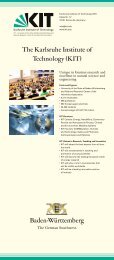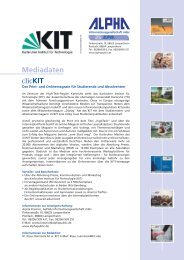lookKIT 02/2011 - PKM - KIT
lookKIT 02/2011 - PKM - KIT
lookKIT 02/2011 - PKM - KIT
Erfolgreiche ePaper selbst erstellen
Machen Sie aus Ihren PDF Publikationen ein blätterbares Flipbook mit unserer einzigartigen Google optimierten e-Paper Software.
<strong>02</strong>11<br />
Ways 39<br />
Information<br />
Downy mildew is a dreaded plant disease in<br />
viniculture. Following infection, leaves and<br />
young berries putrefy, ripeness of the fruit is<br />
delayed, the fruit sugar content is reduced,<br />
and the taste is spoiled. Actually, the different<br />
types of downy mildew are not fungi,<br />
but related to brown algae and diatoms.<br />
Pilzabwehr<br />
durch<br />
Mundgeruch<br />
<strong>KIT</strong>-Forscher bekämpfen<br />
Parasiten der Weinrebe<br />
“To reduce the spraying volume, we urgently need<br />
new concepts for improving crop protection,” says<br />
Professor Nick. A successful approach consists of<br />
crossbreeding fungus-resistant genes from American<br />
wild vines into the cultivated vines. The resulting<br />
vines are immune to the fungus, but unfortunately<br />
also taste of wild vines. It took nearly 100<br />
years to cultivate vines that are both resistant and<br />
tasty. Thanks to modern gene maps and highly developed<br />
molecular biology methods, cultivation today<br />
is much more efficient than it was in the past.<br />
The new method invented by Nick now represents<br />
a rather promising, environmentally compatible approach<br />
that is associated with relatively low costs<br />
and minimum time expenditure. The idea is based<br />
on chemical communication of the plant with other<br />
organisms. By means of attractants, plants can attract<br />
pollinating insects. By releasing volatile scents,<br />
the vines defend themselves against pests. This<br />
strategy is used by Nick and his team.<br />
When they studied wild vines from China and Japan<br />
in more detail, the researchers found that these species<br />
were resistant against downy mildew even when<br />
they had never been in contact with this pathogen.<br />
Infection experiments revealed that the pathogen<br />
obviously does not find the stomata of the Asian<br />
wild vine. To determine the reason, Nick and his<br />
team went to the laboratory of Professor Wilhelm<br />
Boland at the Max Planck Institute of Chemical Ecology<br />
in Jena, which has specialized in the detection<br />
of volatile attractants. With gas chromatographs –<br />
highly sensitive chemical noses – even the smallest<br />
amounts of these attractants can be detected. In<br />
this way, the scientists from Karlsruhe proved that<br />
the vines produce a type of “bad breath;” volatile,<br />
smelling substances, so-called aldehydes, such as<br />
hexenyl acetate and nonanal are released from the<br />
stomata.<br />
To verify their hypothesis, the researchers confronted<br />
the mildew pathogen with the Asian wild vine<br />
attractant and observed that the “fungus” indeed<br />
moves to the source of the scent. With the help<br />
of an attractant, the pathogen can orient well and<br />
rapidly finds the stomata of Müller-Thurgau vines. In<br />
this case, the “bad breath” unintentionally tells the<br />
fungus where the weak point of the vine is.<br />
Nick thinks that Asian wild vines release the attractant<br />
in a decentralized manner, i.e. not only via stomata,<br />
but also from other openings of the plant. This<br />
obviously confuses the fungus so it cannot find the<br />
stomata. Infection experiments of Müller-Thurgau<br />
vine leaves with downy mildew confirmed that the<br />
pathogen does not find the stomata of the leaves, if<br />
large areas of the plant are sprayed with the attractant<br />
nonanal. Hyphae are formed on the leaf surface<br />
only. The fungus is isolated from the supply vein of<br />
its host and condemned to die out.<br />
Nick and his team have also started to solve another<br />
problem. They are now developing a scent that does<br />
not volatilize so rapidly, but is as effective as nonanal.<br />
The next hot summer will certainly come. Covered<br />
by the new biological fungicide, the cultivated<br />
vine will have good chances to win the fight against<br />
downy mildew.<br />
Forscher vom Botanischen Institut des <strong>KIT</strong> haben<br />
einen wirksamen Weg gefunden, die Weinrebe<br />
vor „Schadpilzen“ wie dem falschen Mehltau<br />
biologisch zu schützen – ohne Pestizide und<br />
Genmanipulationen. Das Team um Professor Peter<br />
Nick identifizierte mithilfe asiatischer Wildreben<br />
eine Substanz, mit der man den Pilz davon<br />
ablenken kann, in die Spaltöffnungen einzudringen<br />
und die Blätter zu infizieren.<br />
Der Falsche Mehltau, ein pilzähnlicher Parasit,<br />
der weltweit große Schäden im Weinbau verursacht,<br />
wurde im 19. Jahrhundert aus Amerika<br />
eingeschleppt. Er gelangt in ihr Inneres, breitet<br />
sich großflächig aus und ernährt sich vom Lebenssaft<br />
seines Wirtes. Weil Pflanzenschutzmittel<br />
schnell vom Regen weggespült werden, sind<br />
13 bis 15 Spritzungen pro Saison nötig. Etwa 70<br />
Prozent der Fungizidproduktion gehen allein auf<br />
das Konto des Weinbaus.<br />
„Damit wir weniger spritzen müssen, brauchen<br />
wir dringend neue Konzepte für die Verbesserung<br />
des Pflanzenschutzes“, fordert Professor<br />
Nick. Ein erfolgreicher Weg besteht darin, pilzresistente<br />
Gene amerikanischer Wildreben in die<br />
Kulturrebe einzukreuzen. Man bekommt dann<br />
durchaus Reben, die gegen den Pilz immun<br />
sind. Dank moderner Gen-Karten und hoch entwickelter<br />
molekularbiologischer Techniken ist<br />
Züchtung heute deutlich effizienter als früher.<br />
Die von Nick ersonnene neue Methode stellt<br />
nun einen vielversprechenden, umweltschonenden<br />
Ansatz dar mit relativ geringen Kosten und<br />
minimalem Zeitaufwand. Die Idee beruht auf der<br />
Erforschung der chemischen Kommunikation<br />
der Pflanze mit anderen Organismen. So können<br />
Pflanzen mittels Signalstoffen bestäubende Insekten<br />
anlocken oder sich durch Abgabe flüchtiger<br />
Duftstoffe gegen Fraßfeinde verteidigen.<br />
Michael Rauhe
















